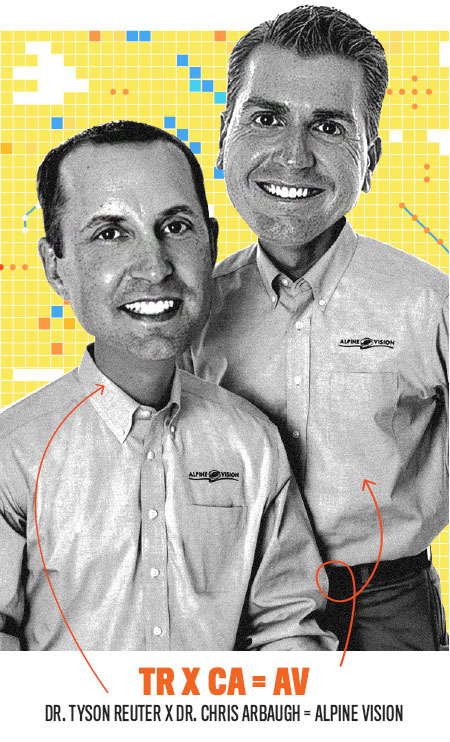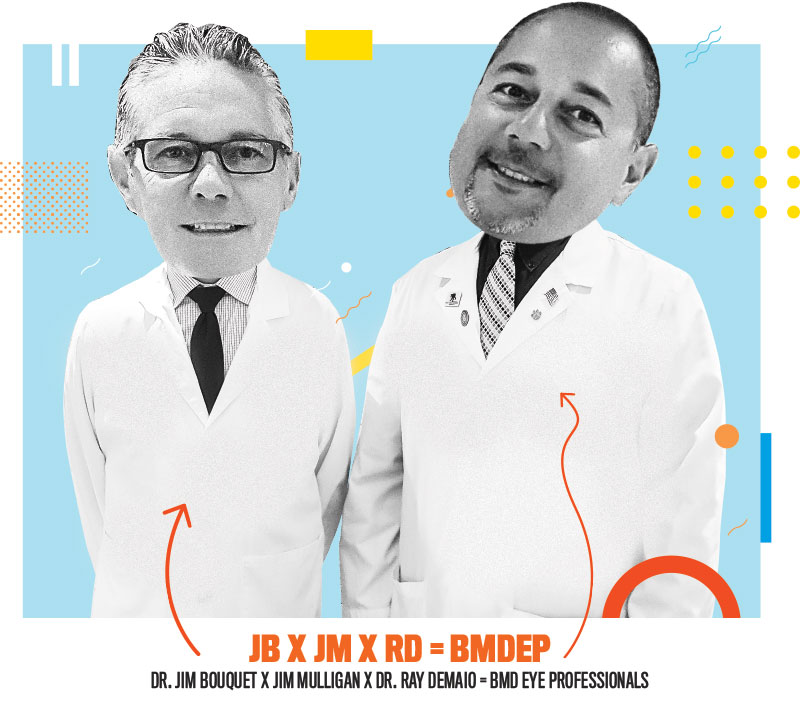Five businesses share what they need to do to make a thing go right.
 STORY BY DANIEL P. SMITH
STORY BY DANIEL P. SMITH
Regardless of industry, region and even financial metrics, the majority of business partnerships in the U.S. — as many as 80 percent by some estimates — fail.
The reasons, of course, are varied: conflicting personalities, unequal commitment to the business, divergent visions of the operation’s future, contrasting viewpoints on company culture or money management, and those dreaded trust issues. Even the most well-intentioned, promising business marriages can implode.
Yet, the fact remains that wonderful, undeniable synergies can come from business partnerships; this potential payoff is the precise reason many such arrangements blossom in the first place. At their best, successful small-business alliances allow partners to share the workload and financial investment, more vigorously pursue expansion opportunities, multiply the number of creative ideas on the table, minimize holes in the operation’s performance and breed the sweet vibes of teamwork done right.
Here are five eyecare operations forging confidently ahead along the partnership route, finding success where so many others have struggled.
Advertisement

ALPINE VISION
Colorado Springs,
Falcon and Windsor, CO
Reuter and Arbaugh opened Alpine Vision soon after graduating from the University of Houston College of Optometry in 2001, their potential union first hatched as a school project that earned — amusingly, in retrospect — a C grade.
“We had to put together a business plan for opening our own office … [and] it was that same plan we used to convince a bank to loan us money to start up,” Arbaugh shares.
Over the past 16 years, the partners have added two locations and moved their original practice into a larger space. Each partner’s role has evolved due to life changes and professional development. To put the partnership in simple terms, Arbaugh handles incoming funds, while Reuter oversees outgoing funds.
Reuter describes Arbaugh as the “go-getter” of the duo, the one attuned to the latest technology and business opportunities. Reuter, meanwhile, is the more conservative and deliberate partner.
Advertisement
“Somewhere in there is the happy medium,” Arbaugh says.
Alpine’s keys to a successful partnership:
- Check your ego. It’s been smooth sailing for the Alpine Vision partners thus far with few significant disagreements. “The fact that neither one of us ever feels like we are too big for the situation has been extremely beneficial,” Reuter says.
- Genuine friendship. “It can’t just be about business all the time,” Arbaugh says. “We’re fortunate enough to be friends as well [and we] both take an interest in each other’s lives outside of the business.”
- Don’t keep score. On any given day, one or the other partner might have to put in a little more effort or work time, or might be on vacation. But Arbaugh and Reuter recognize that everything balances out over time. “Just like any relationship, there is a certain amount of give and take that must be understood,” Reuter says.
- Share a willingness to roll up the sleeves. Neither Arbaugh nor Reuter is above plunging a toilet, painting a room or putting some sweat equity into the business. “The ability to do whatever it takes to help the company, no matter how small or big, is the key ingredient to a successful partnership,” Reuter says.

BUENA VISTA OPTICAL
CHICAGO, IL
The married couple partnership is a popular one in optical but it too requires a clear understanding of what is personal and what is business. This husband-and-wife team first met in 1998 as Sims completed his residency in Puerto Rico. After the couple married in 2001, they fashioned a plan to strike out on their own after years of working for optical operations in Idaho and later Chicago. A true love story, they launched Buena Vista Optical on Chicago’s South Side on Valentine’s Day 2005.
“I thought it’d be me, him and the receptionist,” Canto-Sims says.
Advertisement
Not quite. Buena Vista has blossomed into a three-doctor, 17-staff member operation rooted in an intimate level of trust developed over 16 years of marriage and aligned financial interests.
“Our goals and dreams are the same, which can be one of the hardest things to establish in a business partnership,” Sims says. “What benefits me benefits her.”
Sims handles the optical side of the business, along with managing finances, IT, systems and operations. Canto-Sims plays the creative extrovert to her more introverted, pragmatic husband, overseeing all buying, marketing and public relations, store design and staffing, including hiring and training.
“She has her own office, I have mine and we don’t interfere with one another,” Sims says.
Buena Vista’s keys to a successful partnership:
- Align values. Finances and workplace culture are two areas where partners must agree, the couple says. Both consider themselves frugal and both work to create a professional workplace in which staff members are expected to work with patients and colleagues in a respectful, honest manner. “We know our non-negotiables,” Canto-Sims states.
- Seek complements… not compliments. Sims believes many partners make the mistake of coupling with a carbon copy of themselves. “When you have people with similar skill sets there are not only redundancies, but both can feel they have the right way to approach situations while other areas of the business aren’t getting the attention they deserve,” he says.
- Trust is king. Canto-Sims doesn’t step on her husband’s toes when it comes to financial decisions (“He’s a genius in that area,” she says) and he doesn’t interfere with her HR or marketing work. “So many partnerships fail because of lack of trust, and that resentment kills the business from reaching its potential,” Sims says.

BOUQUET MULLIGAN DEMAIO EYE PROFESSIONALS
Cleona and Elizabethtown, PA
Bouquet and Mulligan, former colleagues at a Pennsylvania retail eyewear operation, launched their business in 1985 from a 2,000-sq-ft office in Cleona. DeMaio, an ophthalmologist, joined the operation in 1995 to establish the modern-day BMD Eye, which now includes more than 40 employees spread across two locations.
The partnership works, Mulligan says, because each partner owns his specialty.
“We are good at what we do and respect each other’s talent,” he explains.
Which isn’t to suggest there haven’t been some tough calls over the years. For example, when BMD Eye’s growth compelled the trio to purchase adjacent properties, the partners had to reach a consensus on the deal’s terms, collectively accepting the risk and agreeing to become landlords, touchy issues that could easily strain a partnership.
“We share those duties and work out any issues during meetings every quarter,” Mulligan says.
But what really drives BMD Eye is a consistent mix of hard work, dedication and trust. “Success can never be achieved without dedication and hard work,” DeMaio says. “A partner must also trust his cohort that he or she will be just as dedicated and that all decisions will be made for the greater good of the partnership.”
BMD Eye’s keys to a successful partnership:
- Mutual concern and respect. A successful partnership, Mulligan contends, requires genuine care among the partners and confidence in each individual’s professional skills, particularly the ability to perform well under pressure and treat patients and fellow employees with dignity.
- Designated arbitrator. If conflicts arise, the BMD Eye partners turn to a third-party adviser they have selected to resolve any disputes. They have each pledged to honor his final decisions. “Fortunately,” Mulligan says, “we rarely call upon him.”
- Strive for individual success. Mulligan says each partner strives to be the top performer in his individual field so the business — and each individual — never becomes too dependent on one partner’s specialty. “I try to be constantly trying new things that make our practice stand out,” Mulligan says of his work on the optical side.

FAMILY VISION CARE
ALMA, GA
From 1997 to 2013, McQuaig trudged along in the eyecare business his father Loren founded in 1955, dutifully serving patients as the only eyecare operation in the Bacon County community of some 13,000 residents. Eventually, it became overwhelming.
“I had reached the maximum I could handle alone,” McQuaig admits.
Fortunately for him, Hutto, whose mother Dana had worked at Family Vision Care for more than two decades, was attending optometry school and interested in returning to his southeastern Georgia roots.
“I told Blake I’d make him a deal he couldn’t refuse,” McQuaig says.
In 2013, a freshly degreed Hutto returned to Alma and accepted McQuaig’s forward-thinking offer, which included an option to buy into the practice by way of Hutto’s time.
Initially, Hutto focused on fine-tuning the business side of the operation, taking a major part of the strain off McQuaig. Today, while McQuaig continues seeing many of his longtime patients, Hutto has successfully integrated new patient blood into the business thanks to his fellow Millennials and the Gen Z set as he follows McQuaig’s path of devoted care to the folks of Bacon County.
“With so many small-town practices going away, it takes someone willing to look at things like Jim did and find a way to make the practice sustainable in a realistic way,” Hutto says. “He laid a foundation for what is best for this practice and has been forthright on how things need to move forward.”
Family Vision Care’s keys to a successful partnership:
- Communicate and conciliate. “Open dialogue is essential,” McQuaig adds. “You will have situations where you might agree to disagree, but you need to come to a consensus so the business wins and the patients win.”
- Be honest. “If you tell the truth,” Hutto says, “then you don’t have to worry about different versions of the story.”
- Honor the end goal. The practice takes precedence, McQuaig and Hutto agree, which is why compromise reigns. “We’re the only eye business in town, so the worst thing for our patients is if we went away, and that’s something neither of us wants given how passionate we both are about this town,” Hutto says.

STRATTON EYES & J. GALT EYEWEAR
Lexington, KY
For many years, Ko and Stratton operated separate practices about two miles apart in Lexington. Mutual patients and industry colleagues told them they shared similar styles and would make a good team — enough of an endorsement that Stratton phoned Ko in 2004 and suggested joining forces.
“My accountant joked that the more heads you put together, the bigger the monster,” Stratton says, “but I really wanted to grow the business and it was something worth exploring.”
Eyeing expansion herself, Ko was on board and the two agreed to a six-month trial period in which Ko worked at Stratton Eyes once a week. The potential synergies were obvious immediately: The two shared similar values about patient care while Stratton’s love of the business side complemented Ko’s foremost interest in patient care. Ko folded her practice into Stratton Eyes and the relationship officially commenced.
Over the past 13 years, the partners have enjoyed exponential growth, moving Stratton Eyes to a bigger location in 2013, adding four additional doctors and opening a second Lexington store in 2016 with the debut of J. Galt Eyewear, the yin to Stratton Eyes’ yang with a hipper, younger marketplace positioning.
“It’s really nothing more than happenstance that we connected, but it’s been a wonderful partnership on so many levels,” Ko says.
Stratton Eyes’ keys to a successful partnership:
- Feeling-out period. A six-month trial let the partners learn about each other personally and professionally.
- Shared successes, failures. “We take 50/50 losses and 50/50 gains and are in this completely together,” Stratton says.
- Legal parachute. Stratton, Ko and an attorney developed a plan that would allow a civil separation if needed. It “alleviated the stress of the partnership [potentially] not working out,” Ko says, as it’s much easier to “get things out in the open early”.